Abstract
In this paper, a novel multiaxial fatigue damage parameter was developed based on the critical plane-energy method. The proposed damage parameter considers the sensitivity difference of the material ductility to the out-of-phase loads and takes the function of material elongation as an adjustment function. At the same time, the mutual promotion of shear stress and normal stress in the process of microcrack propagation was considered to characterize the friction and interlock phenomenon on the crack surface in the new parameter. It is indicated that the new model has reliable prediction results for all verification materials. Furthermore, the new model also has the benefit of not requiring the introduction of a new material constant.
1. Introduction
Multiaxial loads are used for many structural components in engineering, such as airframes and turbines [1,2,3], making the study of multiaxial fatigue extremely important [4]. Multiaxial fatigue is a practical and challenging problem. Despite extensive research on this topic worldwide, there is still a lack of more reliable criteria for multiaxial fatigue due to its complexity and time-consuming and expensive experimental studies [5].
The establishment and evaluation of the multiaxial fatigue criteria have attracted a large number of scholars [6,7]. Four main criteria can be used to classify multiaxial fatigue life prediction methods—stress-based criterion, strain-based criterion, energy-based criterion [8], and machine learning methods [9,10]—as shown in Figure 1. The critical plane criterion is the most widely accepted fatigue theory among them because the experimental results show that in the presence of multiaxial fatigue, both the beginning and the growth of cracks in the materials occur on a specific plane, called the critical plane, rather than randomly [11]. Once the critical plane has been identified, different stresses and strains on the critical plane can be combined in accordance with specific rules to develop multiaxial fatigue life models, such as the maximum shear strain model (MSSM) [12], WB criterion [13], KBM criterion [14] based on the maximum strain criterion, the most popular FS criterion [15], and the stress-based Findley criterion [16]. The expressions for these fatigue criteria are shown in Table 1. In recent years, the effectiveness of data-driven life prediction models has been empirically verified in different engineering fields [17]. However, machine learning-based methods are expensive to apply in practice due to the lack of data.

Figure 1.
The flowchart of multiaxial fatigue life prediction.
The greater life prediction capabilities of the Fatemi–Socie (FS) critical plane model make it more popular than others. The primary reason for crack initiation is thought to be cyclic loading in this model, and the view that the normal stress on the maximum shear strain plane affects the friction and interlocking of the crack surface is consistent with the experimental phenomenon. Furthermore, the FS model states that non-proportional hardening reduces fatigue life. However, to account for the impact of normal stress on crack growth, the FS criterion introduced the material constant k. Fitting k is cumbersome, particularly when test data are limited, and the additional material constant is determined using various approaches, which frequently yields inconsistent life prediction outcomes [18].
Although these damage indicators based on stress and strain alone are widely used, they cannot reasonably express the materials’ constitutive behavior, resulting in unsatisfactory prediction results. However, even though the life prediction criterion based on energy may describe the constitutive behavior of materials, energy is a scalar and does not adequately express the damage mechanism; for this reason, it has drawn criticism. Accordingly, the multiaxial criterion of the energy method considering the theory of the critical plane is further proposed [19,20].
As shown in Table 1, the SWT method, which is the earliest critical plane-energy criterion, is based on the influence of the principal strain range and the maximum stress acting on the critical plane. Because only the normal strain energy is taken into account, this method is typically more accurate in predicting life under uniaxial fatigue load conditions [20]. Liu believed that the damage of materials under multiaxial loadings includes two components—normal strain energy and shear strain energy—and developed the Liu I criterion and the Liu II criterion for different material failure mechanisms, which are suitable for type I failure modes and type II failure modes, respectively [21]. It is important to note that not all normal strain energy will result in damage, since crack closure effects on the surface of the crack may occur [22]. This leads to multiaxial failure of materials, with different weights assigned to the shear strain energy and normal strain energy components. In addition, it is well known that negative average stress increases fatigue life, while positive average stress decreases fatigue life [23]. The Varvani criterion considered the difference in damage between the normal strain energy and shear strain energy on the critical plane by dimensionless treatment of the two sections [24]. Chen et al. criticized and improved the SWT model, known as the CXH model, which took into account both the normal strain energy and the shear strain energy acting on the critical plane and assumed that normal and shear work have the same weight [25]. The CXH model has been demonstrated to have good predictive performance, particularly in ductile materials. However, the effect of average stress was ignored in the CXH model [8]. Although some scholars believe that the material ductility leads to differences in the fatigue life under proportional and non-proportional loads, few life prediction models have taken into account the material ductility parameters so far.

Table 1.
Multiaxial fatigue criteria.
Table 1.
Multiaxial fatigue criteria.
| Criteria | Expression | Refs. | |
|---|---|---|---|
| Stress | Findley | [16] | |
| Strain | MSSM | [12] | |
| KBM | [14] | ||
| WB | [13] | ||
| FS | [15] | ||
| Energy | SWT | [20] | |
| Liu I | [21] | ||
| Liu II | [21] | ||
| Varvani | [24] | ||
| CHX | [25] |
kF, kWB, and kBM are material parameters.
The purpose of this article is to present a balanced multiaxial fatigue damage parameter based on the multiaxial fatigue test results of AA2024-T351. This parameter defines the plane where the maximum shear strain amplitude is located as the critical plane, and the virtual shear strain energy density as the primary control parameter. The combination of ductility parameters and non-proportional load parameters as adjustment parameters and the promotion effect of normal stress and shear stress on the crack surface is also considered. First of all, the Basquin–Manson–Coffin equation was used to correlate damage parameters to construct a life prediction model. Next, the new model was contrasted with the MSSM, SWT, and FS models. The robustness and accuracy of the new model were methodically confirmed using the experimental results of AA2024-T351 and the other five checked materials from the works of literature subjected to multiaxial fatigue loading situations. In addition, the advantage of the new model was that no additional material constant was introduced.
2. Experimental Tests and Results
2.1. Uniaxial Fatigue Experiment
Firstly, AA2024-T351 was taken as the research object. The test was conducted using an Instron 8801 testing system to perform a monotonic tensile test with a displacement control method and a tensile rate of 0.5 mm/min. According to GB/T 228.1-2021 [26], a dumbbell specimen was used to test the mechanical properties of the AA2024-T351, as shown in Figure 2. The monotonic tensile curve is shown in Figure 3, and its tensile properties are shown in Table 2. In order to obtain the fatigue parameters of AA2024-T351, according to ASTM E606 [27], the strain-controlled low-cycle fatigue test was carried out on the non-notched dumbbell specimens with the shape and size of the specimen as shown in Figure 4. The strain amplitude was 0.4%, 0.5%, 0.6%, 0.7%, 0.8%, 0.9%, and 1.0%, and the strain amplitude ratio Rε = −1 with frequency f = 1 Hz. The test was not stopped until the sample fractured.

Figure 2.
Schematic diagram of the monotonic tensile specimens (unit: mm).
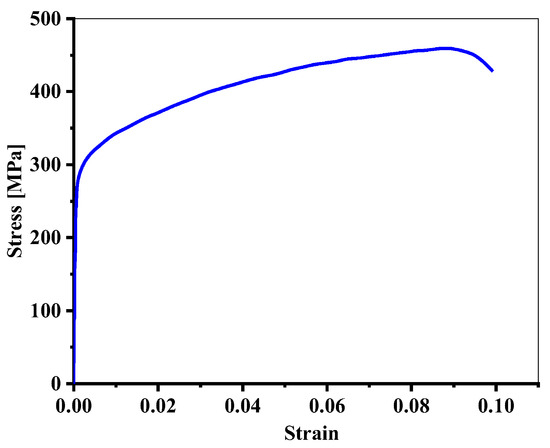
Figure 3.
The monotonic tensile curve of AA2024-T351.

Table 2.
Mechanical properties of AA2024-T351.
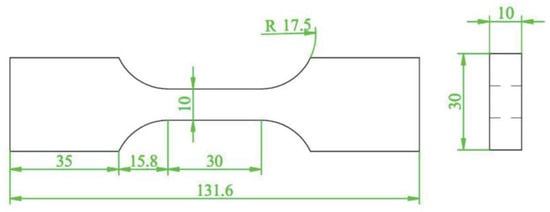
Figure 4.
Schematic diagram of the uniaxial fatigue specimen (unit: mm).
Figure 5 is the uniaxial fatigue test results of AA2024-T351. The Manson–Coffin formula (as Equation (1)) was used to fit the test data. The strain–life curve obtained is shown in Figure 5, and the material fatigue parameters are shown in Table 3.

Figure 5.
Uniaxial fatigue strain–life curve of AA2024-T351.

Table 3.
Fatigue parameters of AA2024-T351.
In Equation (1), εa is the total strain amplitude, εea is the elastic strain amplitude, εpa is the plastic strain amplitude, and and are the fatigue strength coefficient and fatigue ductility coefficient, respectively. b and c are the fatigue strength and ductility exponent, respectively.
2.2. Multiaxial Fatigue Test
Our team conducted a multiaxial fatigue test for AA2024-T351, and the test details fully described in Ref. [28] are briefly summarized here. A thin-walled round tube specimen with a wall thickness of 1.5 mm and an external diameter of 19.8 mm was selected. A uniform surface roughness of 0.2 μm was ensured on the inner and outer surfaces of the specimen to eliminate the influence of machining marks, as shown in Figure 6. All multiaxial strain-controlled fatigue tests were performed at room temperature on a closed-loop servo-hydraulic tensile–torsional testing system, and fatigue tests on tubular specimens were loaded in both axial and torsional directions. The details of the experimental design are shown in Table 4. A triangular waveform that controls the axial strain and torsional strain applied by the load, with a strain ratio equal to −1.0 and a loading frequency of 1 Hz. The strain paths used in this study are in-phase and 90° out-of-phase loading. Each test was performed at equal von Mises strain amplitude values with strain amplitude ratios of 1.73 and 1.24.
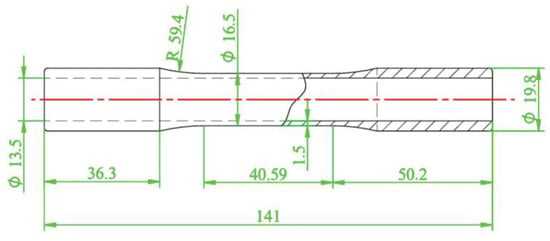
Figure 6.
Schematic diagram of thin-walled round tube specimen (unit: mm).

Table 4.
Multiaxial fatigue life of AA2024-T351 under tensile–torsional loading [28].
The measured values of AA2024-T351 multiaxial fatigue life under different loading paths are shown in Table 3. When the equivalent effect value is 0.0055 and the strain amplitude ratio is 1.73, the average lifetime of the specimen under proportional and non-proportional loads is 7229 cycles and 11,191 cycles, respectively. In a similar case, when the strain amplitude ratio is 1.24, the lifetime of the specimen is 6905 cycles under proportional load, while the average lifetime under non-proportional load is 12,175 cycles. It can be concluded that under the same conditions, the life of AA2024-T351 under proportional load is shorter than that under non-proportional load.
3. Effect of Materials’ Ductility on Multiaxial Fatigue Life
Generally speaking, it is acknowledged that the reduction in fatigue life under out-of-phase loads compared to in-phase loads is caused by multiaxial cyclic hardening. For example, compared to proportional loads, non-proportional loads drastically shorten the fatigue life of ductile materials like wrought aluminum and forged or unwelded steel [29]. Therefore, damage resulting from non-proportional hardening is frequently taken into account by life estimation methods, resulting in accurate predictions. However, in Section 2, the lifetime of AA2024-T351 under non-proportional load is greater than that under proportional load. Also, it has been reported that fatigue life increases under multiaxial non-proportional loads in certain situations; for example, cast magnesium and aluminum alloys with low elongation showed a significantly longer fatigue life under non-proportional loading [30]. As a result, the material’s ductility could influence the damage mechanism. According to reports [31], shear stress(strain) is the primary damage parameter in ductile materials, where the microcrack grows along the maximum shear plane after being nucleated along the slip system. When a crack nucleates in brittle materials, the microcrack grows along the crack surface, and the main damage parameter is normal stress or strain. The interaction between the normal stress and shear stress leads to damage to the semi-ductile material, so the damage parameter is a combination of normal stress(strain) and shear stress(strain). This implies that, as well as the non-proportional hardening parameter, the material’s ductility parameter may also be able to explain the damage.
The fatigue life reduction of specimens from different materials under non-proportional multiaxial load is depicted in Figure 7. The results of tests on four materials’, namely, AA7075 [32], AA2024-T4 [33], GH4169 [34], and 304 stainless steel [35], are presented. The materials’ ductility parameters discussed in this article are derived from the corresponding articles and the material manual.
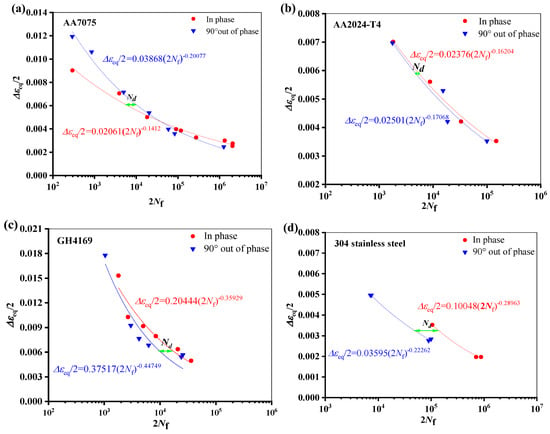
Figure 7.
Effect of load paths on fatigue life at the same equivalent strain amplitude: (a) AA7075, (b) AA2024-T4, (c) GH4169, and (d) 304 stainless steel.
In Figure 4, the abscissa is twice the fatigue lifetime, the ordinate is the equivalence strain amplitude, and the variable Nd represents the degree to which fatigue life under non-proportional loading is reduced in comparison to fatigue life under proportional loading. The expression is as follows: Equation (2) [36].
Nipf represents the fatigue life under a proportional load, and Nnonpf represents the fatigue life under the same equivalent strain amplitude with a 90° non-proportional loading.
In Equation (3), Δε/2 is the axial strain amplitude, Δγ/2 is the shear strain amplitude, and, according to the von Mises criterion, Δεeq/2 is the equivalent strain amplitude.
As seen from Figure 8, in the low cycle region, the life of AA7075 under non-proportional load increases, while the other three materials have a higher ductility level and a greater degree of life attenuation under non-proportional load. Similar cases were reported in the Refs. [29,30]. Figure 9 shows the results of strain-controlled multiaxial fatigue testing on SAE 1050 steel subjected to different quenching and tempering conditions. When the microstructure changes from bainite to more martensite, it is obvious that the material’s toughness is decreased. As can be seen from Figure 9d, the greater the ductility, the more obvious the life reduction under out-of-phase load. There is not much difference in fatigue life between proportional and non-proportional loading situations when the elongation is less than 2%.
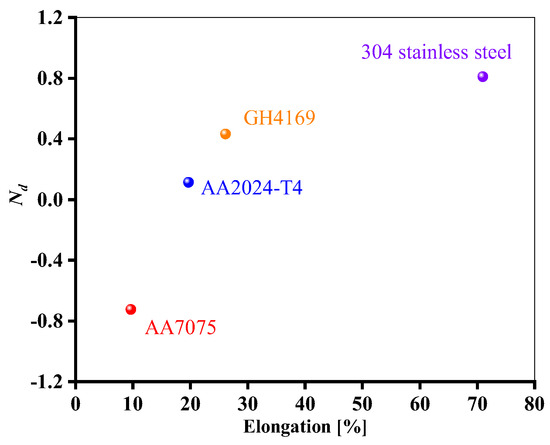
Figure 8.
Effect of materials’ ductility on fatigue life under proportional and 90° non-proportional loadings (Δεeq/2 = 0.006).
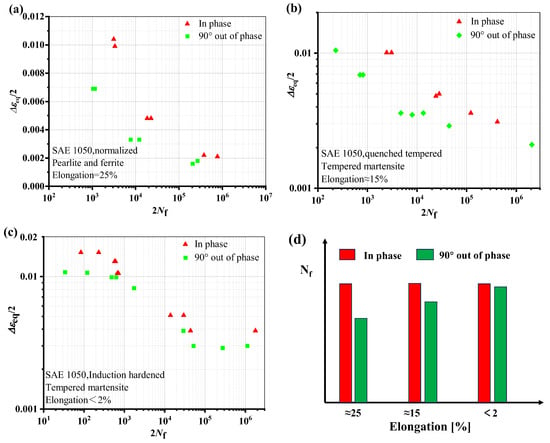
Figure 9.
Effect of material ductility level on fatigue life for in-phase and 90° out-of-phase loads: (a) Elongation is 25%, (b) Elongation is 15%, (c) Elongation less than 2%, (d) Effect of elongation on life under non-proportional loads [30,37].
In light of the results of the above analysis, it will be interesting to establish a relationship between the ductility parameter of the materials (i.e., elongation) and the multiaxial fatigue life.
4. Proposed Critical Plane-Energy Model
4.1. Establishing a Damage Parameter
Regarding the influence as mentioned above, the proposal for this parameter is based on the following three assumptions:
Firstly, the metals’ brittleness and ductility are not absolute, and it can reasonably be considered that the normal component and the shear component work together [8]. However, only a portion of the normal component causes damage because of the different degrees of crack closure effect on the critical plane [38]. Therefore, for the materials with shear failure characteristics, the virtual shear strain energy density at the critical plane is used as the primary index, and the maximum positive stress at the critical plane is used as a secondary index to express the damage the normal component has caused.
Secondly, microscopically, persistent slip bands (PSB) resulting from cyclic plastic deformation are commonly recognized as sources of crack initiation. Experiments have demonstrated that fatigue cracks usually initiate at the plane of the maximum shear strain and that persistent slip bands (PSB) occur very close to the direction of maximum shear strain under different load conditions [39]. Therefore, it has physical significance in determining that the critical plane is the one with the maximum shear strain amplitude.
Then, for most metal materials, the normal stress(strain) decreases as the shear stress(strain) increases, indicating that larger local deformation can overcome friction on the crack surface, and conversely, an increase in the normal stress(strain) can open up the crack surface and reduce the friction. According to Ref. [40], the damage parameter of the FS model can have good stability when GΔγ is used as a normalized parameter, which explains that shear stress and normal stress are mutually promoted. In addition, Xu et al. developed a similar function that reflects the effect of the principal stress on fatigue crack propagation [41]. The formula is as follows:
where σn,max is the maximum normal stress on the critical plane, Δγ and is the range of shear stress on the critical plane, and G is the shear modulus.
Finally, as the phase angle increases, the multiaxial fatigue life decreases. The results in Section 2 show that the higher the material’s ductility, the more sensitive the material is to out-of-phase loads. At the same time, the shear components of highly ductile materials under non-proportional multiaxial loads predominate, and the shear effect is more evident as the ductility level increases. In this study, load non-proportional parameter, Ψ, is determined from the ratio of the minor axis, b, to the major axis, a, of the minimum circumscribed ellipse defined by the strain path (Figure 10) [42], δΨ is used as the adjustment function under different loads at different materials.
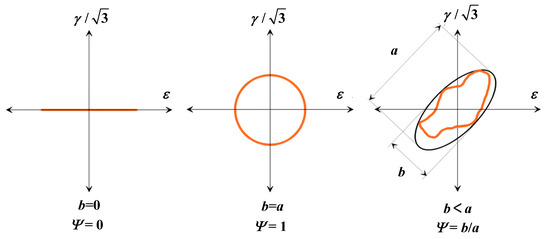
Figure 10.
Load non-proportional parameter [42].
The proposed damage parameter in this study was as shown in Equation (5):
where Δτt/2 is the amplitude of shear stress acting at the critical plane, Δγmax/2 is the maximum shear strain amplitude acting at the critical plane, and δ is the ductility parameter of the material, i.e., elongation. Ψ is the non-proportional factor depending on the strain path.
4.2. Relationship Between Damage Parameter and Fatigue Life
Ellyin proposed cyclic strain energy density as a damage parameter that unifies high and low cycle fatigue by combining plastic strain energy density (ΔWp) and elastic strain energy density (ΔWe) that promotes crack initiation (Figure 11) [43]. The mathematical expressions for the fully reversed strain-controlled low-cycle fatigue results of the tests may be written as Equation (6):
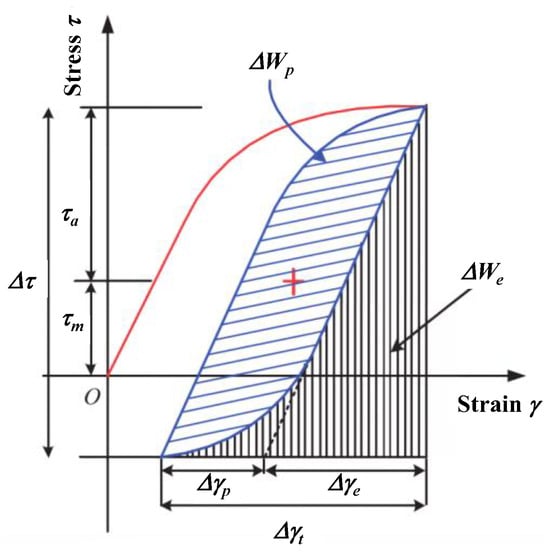
Figure 11.
Cyclic strain energy for a uniaxial stress state [44].
Furthermore, the best-fit line for controlled stress is given by Equation (7):
The total strain energy expression is Equation (8)
Therefore, the relation between the fatigue life and the suggested new damage parameter is Equation (9):
5. Proposed Model Validation and Comparison
5.1. AA2024-T351
This section compared the life prediction performance of the new model with the popular FS model, MSSM, and SWT models under proportional and non-proportional loads. The shear parameters are obtained according to the von Mises equivalence criterion formula are shown in Equations (10)–(13) [45]:
Model prediction errors Perror have been evaluated by a probability analysis to show the differences between these methods visually [38]:
where Perror is the predicted error, Nfp is the predicted life, and Nft is the true life. Block diagrams of prediction errors are created for different life prediction models. As can be seen from Figure 12, The prediction values of MSSM for AA2024-T351 are all within ±2 times the scattering band, but the overall prediction results are large. The life prediction results of the SWT model for AA2024-T351 are greater than the actual values, and the predicted values of the FS model for AA2024-T351 are lower than the experimental values. The prediction results of the proposed model are neither overestimated nor conservative, and most of them are within the ±2 times the scattering band.
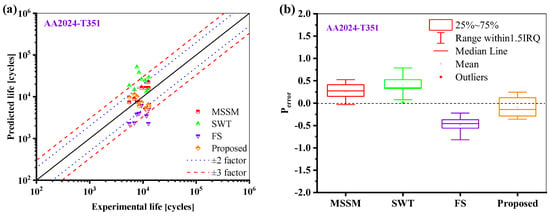
Figure 12.
Comparison of the life prediction results of AA2024-T351 by different models: (a) Experimental life vs. Predicted life, and (b) box plot of predicted error.
5.2. Other Materials
To confirm the precision and universality of the new model in other materials, five kinds of materials, namely, TC4 [12], GH4169 [34], 316LN [46], S460N [47], and pure Ti [48], were evaluated under different load paths. As depicted in Figure 13, the proportional loading path is symbolized by the straight red line, the green ellipse represents the 45° non-proportional load path, and the blue circle represents the 90° non-proportional load path.

Figure 13.
Multiaxial fatigue test load paths.
The uniaxial fatigue parameters of checked materials can be seen in Table 5, and the specific details of the specimen are visible in the references. The ductility parameters of the five materials are given in Table 5 and can also be obtained by consulting the material manual.

Table 5.
Uniaxial fatigue parameters of the checked materials.
The relationship between the fatigue life of the five materials and the damage parameters under the proposed model is depicted in Figure 14. The relationship between the fatigue life and the damage parameters is fitted by the power-law function in a log-log scale, where the fatigue life is represented by the abscissa, and the equivalent damage parameter is defined by the left ordinate, which corresponds to proposed energy models, is the right ordinate. The results show that the damage parameters and life of the five materials have a high goodness of fit, i.e., R2 is greater than 85%, meaning that the damage parameters fall within a narrow scatter band of the curve.
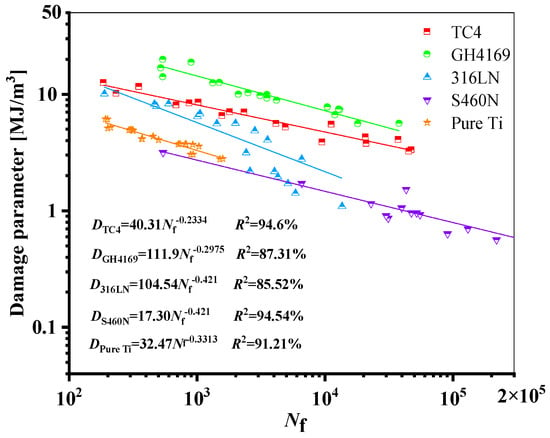
Figure 14.
Damage parameters vs. fatigue failure cycles for the new model for five materials.
The impact of the ductility adjustment function δΨ on the prediction results of the proposed model is depicted in Figure 15, where it is evident that the presence of ductility adjustment parameters can raise the damage value, making the prediction results of the model more accurate and safer.
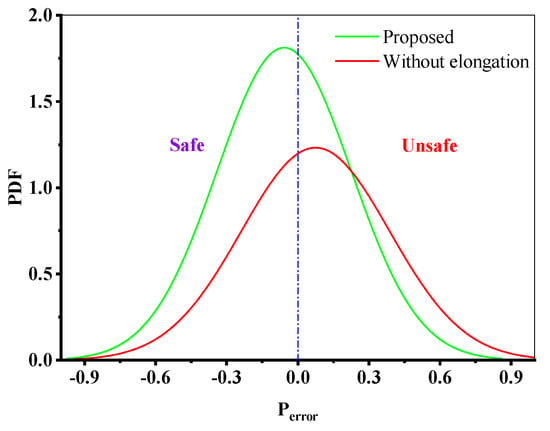
Figure 15.
Effect of the ductility adjustment function of the materials on the Perror of the proposed model.
The prediction results of MSSM for the five materials are displayed in Figure 16. While the fatigue life under proportional loading is typically within ±3 times the scattering band, the results for the fatigue life prediction under 45° and 90° non-proportional loadings are overestimated.
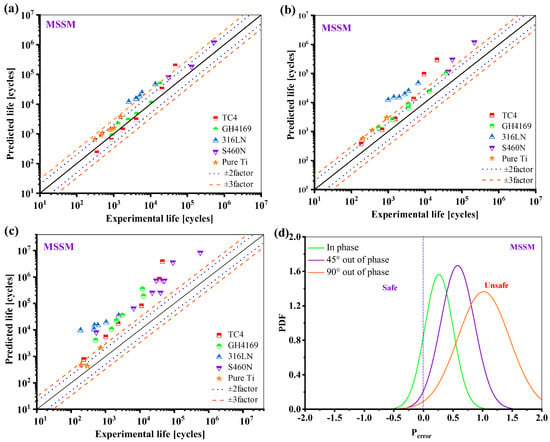
Figure 16.
Prediction results of the MSSM: (a) in phase; (b) 45° out of phase; (c) 90° out of phase, and (d) the probability density function of the Perror.
Since the SWT damage parameter only considers the normal damage for shear failure materials, resulting in a very small damage value, the SWT model overestimates the lifetime predictions for all five materials, as shown in Figure 17.

Figure 17.
Prediction results of SWT model: (a) in phase; (b) 45° out of phase; (c) 90° out of phase, and (d) the probability density function of the Perror.
Most of the life prediction results of the FS model for the five materials are in the range of ±3 times the scattering band, and it can be seen from Figure 18d that the life prediction results of this model are more conservative and accurate under proportional loading.
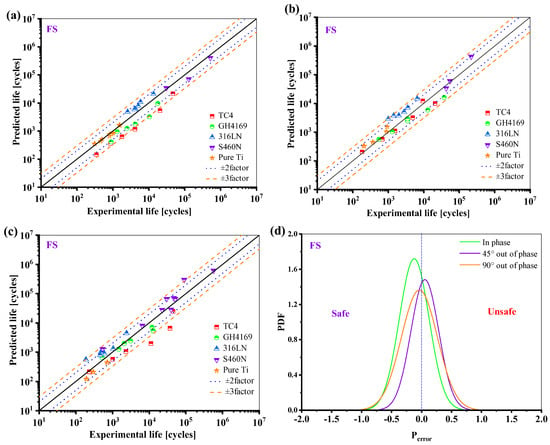
Figure 18.
Prediction results of FS model: (a) in phase; (b) 45° out of phase; (c) 90° out of phase, and (d) the probability density function of the Perror.
Figure 19 shows that for both proportional and non-proportional load paths, most of the prediction results of the proposed model for the five materials fall within the range of ±3 times the scattering band. It is critical to note that the ductility adjustment function has improved the model’s life prediction results under non-proportional loadings, as seen in Figure 19d; the new model is safer, less scattered, and more accurate for life under non-proportional loads.
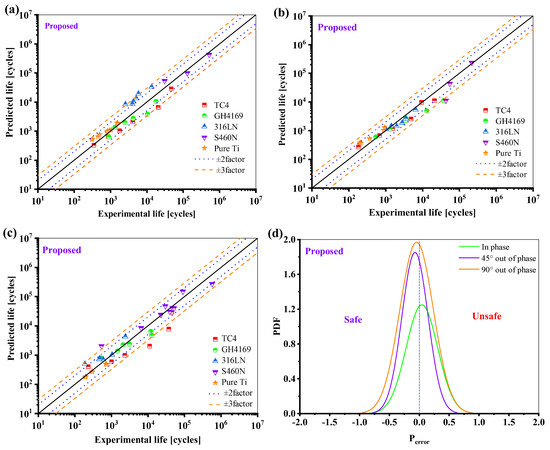
Figure 19.
Prediction results of the proposed model: (a) in phase; (b) 45° out of phase, (c) 90° out of phase, and (d) the probability density function of the Perror.
Regarding the TC4 prediction outcomes, as illustrated in Figure 20b, the new model outperforms the other three models. Comparably, Figure 21a shows that the new model’s damage parameters are less scattered regarding GH4169. Figure 21b shows that the new model’s prediction results are more concentrated and that the mean value is closer to 0.

Figure 20.
(a) Damage parameters vs. fatigue life and (b) box plot of prediction errors for TC4. under multiaxial fatigue loadings.
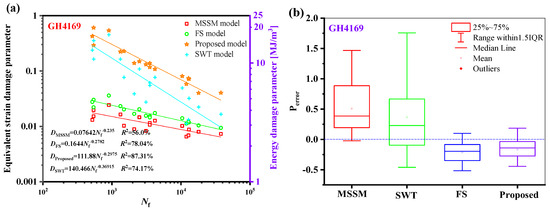
Figure 21.
(a) Damage parameters vs. fatigue life and (b) box plot of prediction errors for GH4169 under multiaxial fatigue loadings.
Figure 22a illustrates that, for the 316LN high ductility material, the dispersion of the new model is superior to the FS model but not as excellent as the MSSM and SWT models. The life prediction findings of 316LN are overestimated by the SWT and FS models. Because the ductility adjustment function has been considered, the new model can effectively increase the damage value and decrease the predicted life, causing the prediction results to be spread on both sides of the experimental value. However, compared to the prediction outcomes of the FS model, the new model is less concentrated.

Figure 22.
(a) Damage parameters vs. fatigue life and (b) box plot of prediction errors for 316LN under multiaxial fatigue loadings.
The suggested damage parameters can be concentrated in a narrow dispersion zone, as seen in Figure 23a and Figure 24a. As shown in Figure 23b and Figure 24b, the fatigue life prediction results of the new model for S460N and pure Ti are more accurate than those of the MSSM and the SWT models. However, the life prediction results of the new model for S460N and pure Ti are similar to those of the FS model.

Figure 23.
(a) Damage parameters vs. fatigue life and (b) box plot of prediction errors for S460N under multiaxial fatigue loadings.

Figure 24.
(a) Damage parameters vs. fatigue life and (b) box plot of prediction errors for pure Ti under multiaxial fatigue loadings.
As shown in Figure 25, the prediction results of the four models are distributed on both sides of the experimental values. Still, the MSSM and the SWT model both give excessively high life prediction results, and the prediction ability of the FS model and the proposed model is similar. It is evident from the fatigue life prediction results of the five materials mentioned above that the new model’s results are reliable and accurate.
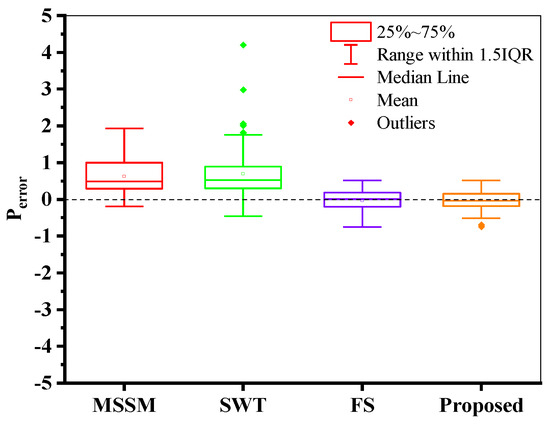
Figure 25.
Box plot of four models’ prediction errors for five checked materials.
Based on the above studies, it is reasonable to consider the ductility parameter of the material as a non-proportional load sensitive parameter under multiaxial loads; however, the model was proposed based on macroscopic phenomenology, and the influence mechanism of ductility on fatigue life should be studies in the future.
6. Conclusions
In this paper, by taking into account the differences in the material ductility under non-proportional loading, as well as the mutual promotion of shear stress and normal stress on the crack surface, a new multiaxial fatigue prediction model is established. Test data from six materials were chosen to confirm the reliability and accuracy of the proposed model. The practical results show the following:
- (1)
- Practice demonstrates that the new damage parameter satisfies the following presumptions: (1) The plane exhibiting the maximum shear strain range is the critical plane of a material with shear failure characteristics. (2) The greater the ductility, the more sensitive the material is to an out-of-phase load, the greater the damage parameter, and the shorter the fatigue life. (3) The normal work and shear work on the critical plane leading to fatigue failure do not have the same weights. (4) The shear component and the normal component on the crack surface have mutually reinforcing effects.
- (2)
- Most of the lifetime prediction results of the proposed model for AA2024-T351 are within the ±2 times scattering band.
- (3)
- The fatigue life predictions of the proposed model for five materials in the literature under multiaxial loading fall within the range of ±3 times the scattering band. In contrast to the model without a ductility adjustment function, the prediction results of the new model are less scattered and safer, and more accurate.
- (4)
- Compared with the MSSM and SWT models, the proposed model can give more accurate and safer prediction results for the fatigue life under both proportional and non-proportional loads. In contrast to the popular FS model, the new model performs better life prediction under non-proportional loading.
Author Contributions
Methodology, X.S.; Conceptualization, X.S.; Resources, Y.D.; Supervision, Y.D.; Funding acquisition, Y.D. and W.G. Data curation, W.G.; Project administration, W.G.; Writing—original draft, X.L.; Validation, X.L.; Writing-review & editing, X.L. All authors have read and agreed to the published version of the manuscript.
Funding
This research was supported by the National Natural Science Foundations of China (Grant No. 52275005) and (Grant No. 52105398), the Fundamental Research Funds for the Central Universities, CHD (Grant No. 300102253201), and the Natural Science Foundation Research Program of Shaanxi Province of China (Grant No. 2022JQ-440).
Institutional Review Board Statement
Not applicable.
Informed Consent Statement
Not applicable.
Data Availability Statement
The raw data supporting the conclusions of this article will be made available by the authors on request. As the raw data for AA2024-T351 in the manuscript is part of an ongoing study, further details on AA2024-T351 cannot be provided. Therefore, the data provided is limited.
Conflicts of Interest
Author Wanjin Guo was employed by the company EFORT Intelligent Equipment, Co., Ltd. The remaining authors declare that the research was conducted in the absence of any commercial or financial relationships that could be construed as a potential conflict of interest.
Nomenclature
| Δγmax | the maximum shear strain range acting on the critical plane |
| σn,max | maximum normal stress acting on the critical plane |
| Δτt | shear stress acting on the critical plane |
| Δσn | normal stress acting on the critical plane |
| Δεn | normal strain acting on the critical plane |
| k | material constant of FS model |
| σy | the yield strength |
| σu | the ultimate strength |
| Hv | Vickers hardness |
| φ | phase difference |
| v | Poisson’s ratio |
| shear fatigue strength coefficient | |
| shear fatigue ductility coefficient | |
| b0 | shear fatigue strength exponent |
| c0 | shear fatigue ductility exponent |
| fatigue strength coefficient | |
| fatigue ductility coefficient | |
| b | fatigue strength exponent |
| c | fatigue ductility exponent |
| E | modulus of elasticity |
| G | shear modulus |
| Nipf | fatigue life under proportional load |
| Nf | fatigue life |
| Nnonpf | fatigue life under non-proportional load |
| Nd | the degree of life reduction due to non-proportional loading |
| Ψ | load non-proportional factor |
| δ | elongation |
| Δγe/2 | elastic strain amplitude |
| Δγp/2 | plastic strain amplitude |
| Δγ/2 | total strain amplitude |
| Perror | life prediction error |
| Nfp | predicted life |
| Nft | actual life |
References
- Almamoori, M.; Alizadeh, Y. A novel approach to multiaxial fatigue life prediction using the critical plane and phase difference angle. Eng. Fail. Anal. 2023, 154, 107654. [Google Scholar]
- Susmel, L.; Hattingh, D.G.; James, M.N.; Tovo, R. Multiaxial fatigue assessment of friction stir welded tubular joints of Al 6082-T6. Int. J. Fatigue 2017, 101, 282–296. [Google Scholar]
- He, Y.B.; Liu, J.H.; Lu, J.M.; Wang, J.; Feng, R.; Ren, J. Probabilistic fatigue evaluation of notched specimens considering small sample properties under multiaxial loading. Theor. Appl. Fract. Mech. 2024, 130, 104316. [Google Scholar]
- Tao, Z.Q.; Pan, X.N.; Zhang, Z.L.; Chen, H.; Li, L.-X. Multiaxial fatigue lifetime estimation based on the new equivalent strain energy damage model under variable amplitude loading. Crystals 2024, 14, 825. [Google Scholar] [CrossRef]
- Liu, X.L.; Song, X.D.; Guo, W.J.; Liu, J.; Dong, Y. Research on probability model and reliability of multiaxial fatigue life based on Huffman model. Int. J. Fatigue 2025, 191, 108675. [Google Scholar]
- Fatemi, A.; Shamsaei, N. Multiaxial fatigue: An overview and some approximation models for life estimation. Int. J. Fatigue 2011, 149, 948–958. [Google Scholar]
- Yakovchuk, P.V.; Savchuk, E.V.; Shukayev, S.M. Critical Plane Approach-Based Fatigue Life Prediction for Multiaxial Loading: A New Model and its Verification. Strength Mater. 2024, 56, 281–291. [Google Scholar]
- Yang, S.; Sun, J. Multiaxial fatigue life assessment of 304 austenitic stainless steel with a novel energy-based criterion. Int. J. Fatigue 2022, 159, 106728. [Google Scholar]
- Zhao, B.F.; Song, J.X.; Xie, L.Y.; Ma, H.; Li, H.; Ren, J.; Sun, W. Multiaxial fatigue life prediction method based on the back-propagation neural network. Int. J. Fatigue 2023, 166, 107274. [Google Scholar]
- Pałczynsk, K.; Skibicki, D.; Pejkowski, Ł. Application of machine learning methods in multiaxial fatigue life prediction. Fatigue Fract. Eng. Mater. Struct. 2023, 46, 416–432. [Google Scholar] [CrossRef]
- Abasolo, M.; Santasmartas, L.P.; Eizmendi, M. A New Critical Plane Multiaxial Fatigue Criterion with an Exponent to Account for High Mean Stress Effect. Metals 2024, 14, 964. [Google Scholar] [CrossRef]
- Wu, Z.R.; Hu, X.T.; Song, Y.D. Multiaxial fatigue life prediction for titanium alloy TC4 under proportional and nonproportional loading. Int. J. Fatigue 2014, 59, 170–175. [Google Scholar]
- Wang, C.H.; Brown, M.W. Life prediction techniques for variable amplitude multiaxial fatigue—Part Ⅰ: Theories. J. Eng. Mater. Technol. 1996, 118, 367–370. [Google Scholar]
- Brown, M.W.; Miller, K.J. A Theory for Fatigue Failure under Multiaxial Stress-Strain Conditions. Mech. Eng. 1973, 187, 745–755. [Google Scholar]
- Fatemi, A.; Socie, D.F. A critical plane approach to multiaxial fatigue damage including out-of-phase loading. Fatigue Fract. Eng. Mater. Struct. 1988, 11, 149–165. [Google Scholar] [CrossRef]
- Findley, W.N. A Theory for the Effect of Mean Stress on Fatigue of Metals Under Combined Torsion and Axial Load or Bending. J. Manuf. Sci. Eng. 1959, 81, 301–305. [Google Scholar]
- Gan, L.; Fan, Z.M.; Wu, H.; Zhong, Z. Prediction of multiaxial fatigue life with a data-driven knowledge transfer model. Int. J. Fatigue 2025, 190, 108636. [Google Scholar]
- Xu, S.; Zhu, S.P.; Hao, Y.Z. A new critical plane-energy model for multiaxial fatigue life prediction of turbine disc alloys. Eng. Fail. Anal. 2018, 93, 55–63. [Google Scholar]
- Arora, P.; Gupta, S.K.; Samal, M.K.; Chattopadhyay, J. Development of new critical plane model for assessment of fatigue life under mult-iaxial loading conditions. Int. J. Fatigue 2019, 129, 105209. [Google Scholar]
- Smith, K.N.; Watson, P.; Topper, T.H. A stress-strain function for the fatigue of metals. J. Mater. 1970, 5, 767–778. [Google Scholar]
- Liu, K. Method based on virtual strain-energy parameters for multiaxial fatigue life prediction. ASTM Int. 1993, 1191, 67–84. [Google Scholar]
- Gates, N.; Fatemi, A. Friction and roughness induced closure effects on shear-mode crack growth and branching mechanisms. Int. J. Fatigue 2016, 92, 442–458. [Google Scholar]
- Li, J.; Wang, X.; Li, R.T. Multiaxial fatigue life prediction for metals by means of an improved strain energy density-based critical plane criterion. Eur. J. Mech./A Solids 2021, 90, 104253. [Google Scholar] [CrossRef]
- Varvani-Farahani, A. A new energy-critical plane parameter for fatigue life assessment of various metallic materials subjected to in-phase and out-of-phase multiaxial fatigue loading conditions. Int. J. Fatigue 2000, 22, 295–305. [Google Scholar]
- Chen, X.; Xu, S.; Huang, D. A critical plane-strain energy density criterion for multiaxial low-cycle fatigue under non-proportional loading. Fatigue Fract. Eng. Mater. Struct. 2003, 22, 679–686. [Google Scholar]
- GB/T 228.1-2021; Metallic Materials—Tensile Testing—Part 1: Method of Test at Room Temperature. Chinese Standard Press: Beijing, China, 2021.
- ASTM E606; Standard Test Method for Strain-Controlled Fatigue Testing. ASTM: West Conshohocken, PA, USA, 2021.
- Liu, X.T.; Guo, W.J.; Song, X.D.; Dong, Y.; Yang, Z. Experimental study of the fatigue failure behavior of aluminum alloy 2024-T351 under multiaxial loading. Eng. Fail. Anal. 2024, 164, 108684. [Google Scholar] [CrossRef]
- Sonsino, C.M. Influence of material’s ductility and local deformation mode on multiaxial fatigue response. Int. J. Fatigue 2011, 33, 930–947. [Google Scholar] [CrossRef]
- Sonsino, C.M. Multiaxial fatigue life response depending on proportionality grade between normal and shear strains/stresses and material ductility. Int. J. Fatigue 2020, 135, 105468. [Google Scholar]
- Mei, J.F.; Dong, P.S. Modeling of path-dependent multi-axial fatigue damage in aluminum alloys. Int. J. Fatigue 2017, 95, 252–263. [Google Scholar]
- Zhao, T.; Jiang, Y. Fatigue of 7075-T651 aluminum alloy. Int. J. Fatigue 2008, 30, 834–849. [Google Scholar] [CrossRef]
- Wang, X.J. Multiaxial Fatigue of 2024-T4 Aluminum Alloy. Chin. J. Mech. Eng. 2011, 24, 33–39. [Google Scholar]
- Wu, Z.R.; Li, X.; Fang, L.; Song, Y.D. Evaluation of multiaxial fatigue life prediction criteria for Ni-based superalloy GH4169. Proc. Inst. Mech. Eng. Part C J. Mech. Eng. Sci. 2017, 232, 1823–1837. [Google Scholar]
- Socie, D. Multiaxial fatigue damage models. J. Eng. Mater. Technol. 1987, 109, 293–298. [Google Scholar]
- Borodii, M.; Shukaev, S. Additional cyclic strain hardening and its relation to material structure, mechanical characteristics, and lifetime. Int. J. Fatigue 2007, 29, 1184–1191. [Google Scholar]
- Shamsaei, N.; Fatemi, A. Effect of hardness on multiaxial fatigue behaviour and some simple approximations for steels. Fatigue Fract. Eng. Mater. Struct. 2009, 32, 631–646. [Google Scholar]
- Ren, Z.; Qin, X.; Zhang, Q.; Sun, Y. Multiaxial fatigue life prediction model based on an improved strain energy density criterion. Int. J. Press. Vessel. Pip. 2022, 199, 104724. [Google Scholar]
- Arora, P.; Gupta, S.K.; Bhasin, V.; Singh, R.K.; Sivaprasad, S.; Tarafder, S. Testing and assessment of fatigue life prediction models for Indian PHWRs piping material under multi-axial load cycling. Int. J. Fatigue 2016, 85, 98–113. [Google Scholar]
- Gates, N.R.; Fatemi, A. On the consideration of normal and shear stress interaction in multiaxial fatigue damage analysis. Int. J. Fatigue 2017, 100, 322–336. [Google Scholar]
- Xu, S.; Zhu, S.P.; Hao, Y.Z. Critical plane–based multiaxial fatigue life prediction of turbine disk alloys by refining normal stress sensitivity. JSA 2018, 53, 719–729. [Google Scholar]
- Noban, M.; Jahed, H.; Ibrahim, E.; Ince, A. Load path sensitivity and fatigue life estimation of 30CrNiMo8HH. Int. J. Fatigue 2012, 37, 123–133. [Google Scholar]
- Golos, K.; Ellyin, F. A Total Strain Energy Density Theory for Cumulative Fatigue Damage. J. Press. Vessel Technol. 1988, 110, 36–41. [Google Scholar]
- Zhu, S.P.; Lei, Q.; Huang, H.Z.; Yang, Y.J.; Peng, W. Mean stress effect correction in strain energy-based fatigue life prediction of metals. Int. J. Damage Mech. 2016, 26, 1219–1241. [Google Scholar]
- McClaflin, D. Torsional deformation and fatigue of hardened steel including mean stress and stress gradient effects. Int. J. Fatigue 2004, 26, 773–784. [Google Scholar]
- Li, Y.; Ren, B.; Chen, X. Cyclic Deformation and Low-Cycle Fatigue for 316LN Stainless Steel under Non-Proportional Loading. MATEC Web Conf. 2019, 300, 08002. [Google Scholar]
- Jiang, Y.; Hertel, O.; Vormwald, M. An experimental evaluation of three critical plane multiaxial fatigue criteria. Int. J. Fatigue 2007, 29, 1490–1502. [Google Scholar]
- Shamsaei, N.; Gladskyi, M.; Panasovskyi, K.; Shukaev, S.; Fatemi, A. Multiaxial fatigue of titanium including step loading and load path alteration and sequence effects. Int. J. Fatigue 2010, 32, 1862–1874. [Google Scholar]
- An, X.L.; Chu, C.L.; Zhou, L.; Chu, P.K. Evolution of microstructures and properties of the GH4169 superalloy during short-term and high-temperature processing. Mater. Sci. Eng. A 2019, 744, 255–266. [Google Scholar]
- Feng, E.S.; Wang, X.G.; Jiang, C. A new multiaxial fatigue model for life prediction based on energy dissipation evaluation. Int. J. Fatigue 2019, 122, 1–8. [Google Scholar]
- Zerres, P.; Brüning, J.; Vormwald, M.M. Fatigue crack growth behavior of fine-grained steel S460N under proportional and non-proportional loading. Eng. Fract. Mech. 2010, 77, 1822–1834. [Google Scholar]
- Liu, B.X.; Huang, L.J.; Wang, B.; Geng, L. Effect of pure Ti thickness on the tensile behavior of laminated Ti-TiBw/Ti composites. Mater. Sci. Eng. A 2014, 617, 115–120. [Google Scholar]
Disclaimer/Publisher’s Note: The statements, opinions and data contained in all publications are solely those of the individual author(s) and contributor(s) and not of MDPI and/or the editor(s). MDPI and/or the editor(s) disclaim responsibility for any injury to people or property resulting from any ideas, methods, instructions or products referred to in the content. |
© 2025 by the authors. Licensee MDPI, Basel, Switzerland. This article is an open access article distributed under the terms and conditions of the Creative Commons Attribution (CC BY) license (https://creativecommons.org/licenses/by/4.0/).

